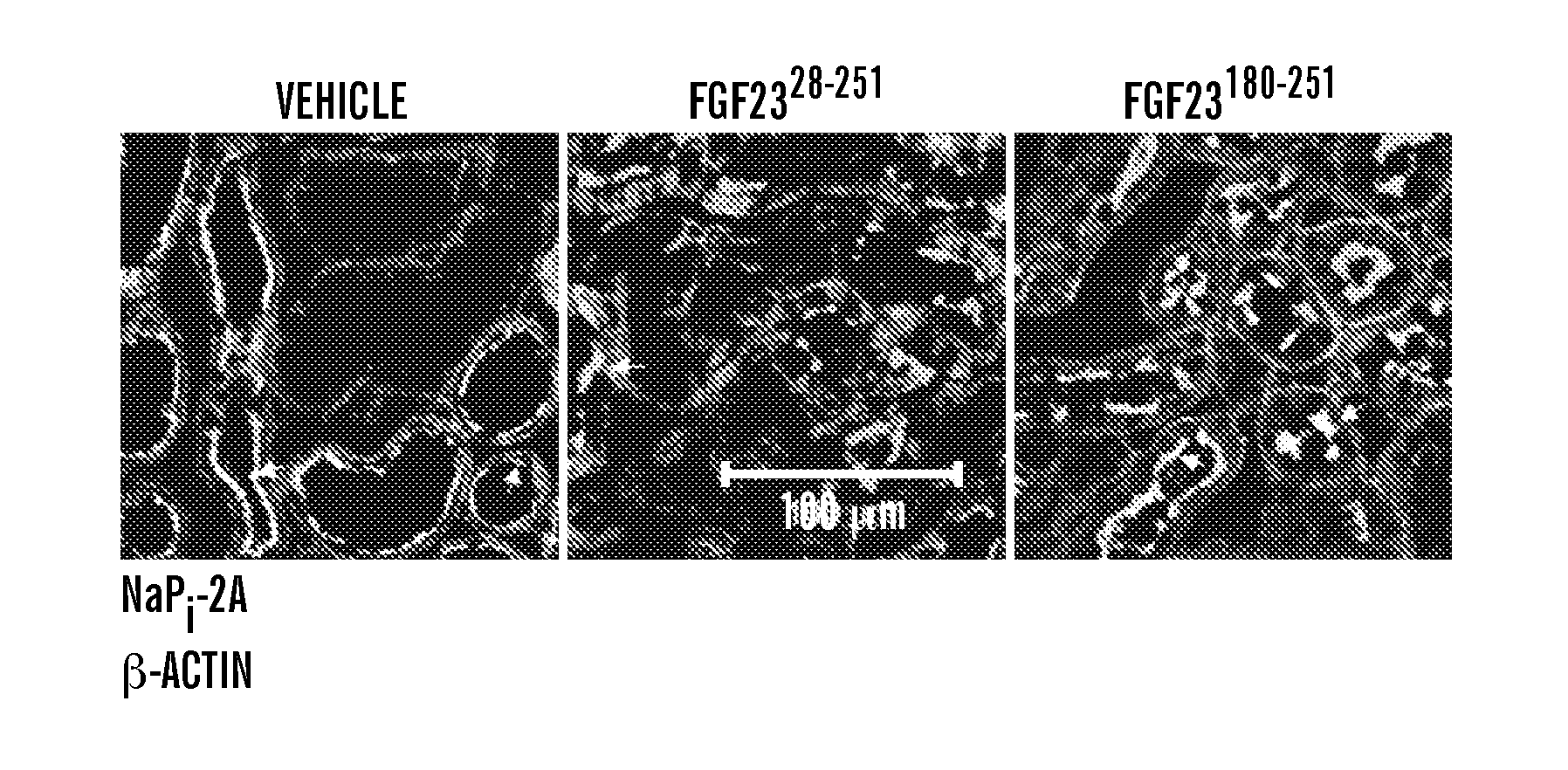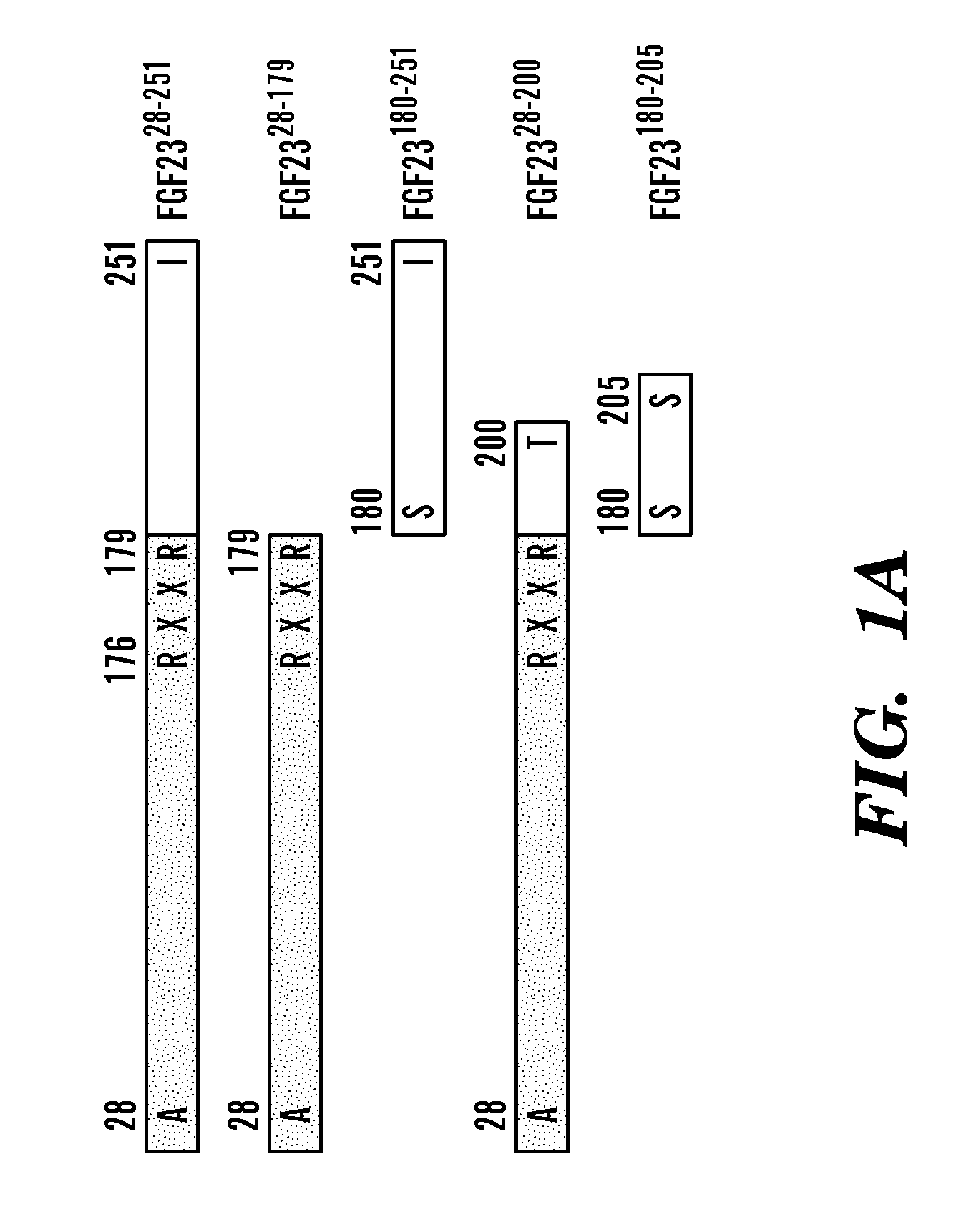Inhibiting binding of fgf23 to the binary fgfr-klotho complex for the treatment of hypophosphatemia
a phosphate homeostasis and phosphate inhibitor technology, applied in the field of inhibiting the binding of fgf23 to the binary fgfrklotho complex for the treatment of hypophosphatemia, can solve the problems of inability to achieve parenteral regimens for chronic disorders, adverse effects of phosphate homeostasis on essentially every major tissue/organ, and insufficient replacement therapy alone. to achieve the effect of inhibiting fgf23 signaling
- Summary
- Abstract
- Description
- Claims
- Application Information
AI Technical Summary
Benefits of technology
Problems solved by technology
Method used
Image
Examples
example 1
C-terminal Tail of FGF23 Mediates Binding of FGF23 to a De Novo Site at the Composite FGFR1c-Klotho Interface
[0108]To understand how FGF23, FGFR and Klotho interact to form a ternary complex, the ternary complex was reconstituted in solution using bioactive, full-length FGF23 (FGF2328-251; FIG. 1A), and the soluble ectodomains of FGFR1c and Klotho. The binary complex of FGFR1c ectodomain with Klotho ectodomain was formed by capturing the Klotho ectodomain onto an FGFR1c affinity column from conditioned media of a HEK293 cell line ectopically expressing the Klotho ectodomain (Kurosu et al., “Regulation of Fibroblast Growth Factor-23 Signaling by Klotho,”J Biol Chem 281(10):6120-6123 (2006), which is hereby incorporated by reference in its entirety). The FGFR1c-Klotho complex was further purified by size-exclusion chromatography to remove excess FGFR1c (FIG. 1B). Next, the FGFR1c-Klotho complex was mixed with FGF2328-251, and ternary complex formation was examined by size-exclusion ch...
example 2
C-terminal Tail of FGF23 Competes with Full-length FGF23 for Binding to the Binary FGFR-Klotho Complex
[0112]To fully nail down that the C-terminal tail of FGF23 mediates FGF23 binding to the binary FGFR1c-Klotho complex, a fixed concentration of FGFR1c-Klotho was mixed with increasing concentrations of FGF23180-251, and the mixtures were passed over the FGF23 chip. Mixtures of FGF2328-251 with FGFR1c-Klotho were used as a control. As shown in FIGS. 3A and D, FGF23180-251 competed, in a dose-dependent fashion, with FGF2328-251 for binding to the FGFR1c-Klotho complex. Half-maximum inhibition of FGFR1c-Klotho binding to FGF2328-251 was reached with a 3.3-fold molar excess of FGF23180-251 over FGFR1c-Klotho complex (FIG. 3D). As expected, less than an equimolar amount of FGF2328-251 relative to FGFR1c-Klotho complex already yielded 50% inhibition of binding of the binary complex to immobilized FGF2328-251 (FIGS. 3C and D). Similar results were obtained using the “reverse” SPR assay for...
example 3
Residues S180 to T200 of the C-terminal Tail of FGF23 Comprise the Minimal Binding Epitope for the FGFR-Klotho Complex
[0113]In follow-up studies, it was found that FGF2328-200, which lacks the last 51 C-terminal amino acids, still retains the ability to co-immunoprecipitate with the binary FGFR-Klotho complex (FIG. 2D). The finding suggested that FGF2328-200 may have similar biological activity as the full-length protein. To test this, the ability of FGF2328-200 and FGF2328-251 to induce tyrosine phosphorylation of FGF receptor substrate 2α (FRS2α) and downstream activation of MAP kinase cascade in Klotho-expressing cultured cells, and to induce phosphaturia in mice, was examined. As shown in FIG. 5A, FGF2328-20° induced phosphorylation of FRS2α and downstream activation of MAP kinase cascade at a dose comparable to that of FGF2328-251. The truncated FGF23 was also nearly as effective as the full-length ligand in reducing serum phosphate concentration in healthy C57BL / 6 mice (FIG. 5...
PUM
 Login to View More
Login to View More Abstract
Description
Claims
Application Information
 Login to View More
Login to View More - R&D
- Intellectual Property
- Life Sciences
- Materials
- Tech Scout
- Unparalleled Data Quality
- Higher Quality Content
- 60% Fewer Hallucinations
Browse by: Latest US Patents, China's latest patents, Technical Efficacy Thesaurus, Application Domain, Technology Topic, Popular Technical Reports.
© 2025 PatSnap. All rights reserved.Legal|Privacy policy|Modern Slavery Act Transparency Statement|Sitemap|About US| Contact US: help@patsnap.com



